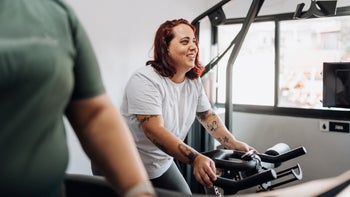
Here’s How to Build a Calisthenics Workout Plan for Beginners
Key takeaways:
Calisthenics is an equipment-free form of strength training that uses your body weight for resistance.
Exercises focus on building functional fitness, including strength, balance, mobility, and endurance.
People of all fitness levels can do calisthenics. A calisthenics workout plan for beginners should include bodyweight exercises, such as push-ups, squats, and lunges.
Table of contents

You've probably done calisthenics exercises before, even if you didn't know it. Bodyweight exercises –– including push-ups, pull-ups, and squats –– are the foundation of this training method. A calisthenics workout plan for beginners will include several of these foundational exercises.
Calisthenics can help you improve muscle strength, balance, and mobility. Once you master the basic moves, you can move on to more advanced exercises that even the fittest athletes find challenging.
What is calisthenics?
Calisthenics is a form of strength training that relies on your body weight for resistance. And it's nothing new. In fact, it dates back to ancient Greece. Fast forward thousands of years to your middle school PE class, where you likely did many calisthenics exercises. You might have found them boring at the time. But calisthenics can be a lot of fun. It's also a great way to get in shape, and no equipment or gym membership is required.
Save over 40% on Qsymia with GoodRx
Discover the once daily Qsymia for weight management. Qsymia is for adults and children 12-17 in combination with a healthy diet and regular exercise.

Here are some key benefits of calisthenics.
Builds muscle mass and strength
Your muscles grow stronger in response to stress. Resistance training — with free weights, machines, or your body weight — causes microscopic tears in muscle fibers. Your body repairs the damage and adapts to the stress, becoming stronger. Calisthenics exercises can be just as challenging and effective for building muscle as traditional weight training.
Improves functional fitness
Functional fitness refers to your ability to move and complete daily tasks without injury. Calisthenics exercises build functional fitness by mimicking movements –– such as lifting, squatting, and lunging –– you make in your everyday life. Your body moves in all directions, and your muscles and joints must move through their full range of motion. You build not only strength but also mobility, coordination, and balance.
Boosts heart health
Cardio exercise is the go-to for heart health. But resistance training is good for your heart, too. One study found that women who did resistance exercises had a lower risk of heart disease.
Another study tested different exercises in adults who sat for long periods. One group did 2 minutes of calisthenics exercises throughout the day. They burned more calories and boosted their heart rate more than those who stood or walked on a treadmill for 2 minutes.
Provides convenient exercise
How many times have you skipped your workout because you couldn't make it to the gym or a fitness class? With calisthenics, all you need is your body weight to get in a workout anywhere, anytime. You can break up your day with a few exercise sets and still get the benefits of a full workout.
Read more like this
Explore these related articles, suggested for readers like you.
In a small study, adults practiced several sets of calisthenics exercises throughout the day. After 4 weeks, they had better balance and muscle strength.
Works for all fitness levels
From beginners to seasoned athletes, calisthenics exercises can help you reach your fitness goals. You can easily modify exercises to make them accessible but challenging for people of all fitness levels.
Calisthenics workout for beginners
Experts recommend doing two muscle-strengthening workouts per week. Calisthenics is a great way for beginners to meet that goal. All you need is 20 to 30 minutes and a little bit of room to move.
Try adding the following exercises to your beginner-friendly calisthenics workout plan. These moves will build the foundation you need to progress to more advanced exercises, such as burpees and mountain climbers.
1. Push-ups
Push-ups target muscles in your chest, arms, and shoulders. But they also strengthen your core (abdominals, sides, and lower back) and leg muscles. You can modify push-ups to make them easier or more advanced. If this move is too challenging at first, you can modify it by keeping your knees on the floor.
Step 1: Get down on your hands and knees. Place your palms flat on the floor shoulder-width apart and align your shoulders over your wrists.
Step 2: Lift your knees off the floor, and walk your feet back until your body comes into a plank position. Keep your toes tucked under, and make sure your body is in one straight line from your heels to your shoulders. Contract the muscles around your core.
Step 3: Slowly start to bend your elbows out to the sides, and lower your body toward the floor, keeping your body rigid and in a straight line. Don’t let your hips sag or pike up.
Step 4: Lower your body until your chest touches the ground, then begin to reverse the movement. Press back up until your arms are straight, keeping your hips, head, and heels in one line.
Step 5: Do 2-4 sets of 8-12 repetitions.
2. Squats
Squats are compound exercises that engage multiple muscle groups, including the quadriceps, hamstrings, glutes, and core, and promote overall lower-body strength and stability.
Step 1: Stand with your feet hip-width apart, toes pointing slightly outward. Keep your back straight, chest up, and engage your core muscles.
Step 2: Begin to bend your knees and lower down, pushing your hips back as if you were about to sit down in a chair. Keep your weight on your heels and your knees aligned over your toes.
Step 3: Lower your body down until your thighs are parallel to the floor or as far as your flexibility allows while keeping your chest up and back straight.
Step 4: Press through your heels and straighten your legs to return to the starting position.
Step 5: Do 2-4 sets of 10-15 repetitions.
3. Lunges
Lunges are another compound exercise that targets multiple lower-body muscle groups, including the quadriceps, hamstrings, glutes, and calves. They build strength, balance, stability, and flexibility.
Step 1: Stand tall with your feet together, shoulders relaxed, and core engaged.
Step 2: Take a controlled step forward with one leg, keeping the other leg in place. Land the front foot 2 to 3 feet in front of you, sole of the foot flat on the floor. The heel of the back foot will lift off the ground; stay balanced on the ball of your foot.
Step 3: Lower your body by bending both knees until the front thigh is parallel to the ground and the back knee is nearly touching the floor. Keep your torso upright, and your front knee aligned over your ankle.
Step 4: Push off your front foot and return to the starting position, bringing your front foot back to meet your back foot. Maintain control throughout the movement.
Step 5: Switch sides, stepping forward with your other foot and lowering yourself into a lunge position. Maintain a smooth and controlled motion, keeping your balance and stability.
Step 6: Do 2-3 sets of 8-12 repetitions on each side.
4. Planks
Planks are a core-strengthening exercise that primarily works the abdominals and back muscles. They also work the small stabilizer muscles of the shoulders and legs.
Step 1: Lie face down on the floor or an exercise mat. Position your elbows directly under your shoulders, forearms flat on the ground, and palms facing down. Extend your legs straight behind you, toes tucked under, and lift your body off the ground, supporting your weight on your forearms and toes.
Step 2: Keep your body in a straight line from your head to your heels. Engage your core muscles to keep your back flat and prevent your hips from sagging or raising up.
Step 3: Hold this position for 10-30 seconds. Focus on keeping your core muscles engaged and breathing steadily.
Step 4: Gently lower your body back to the starting position, relaxing your core muscles.
Step 5: Do 1-3 sets. Aim to gradually increase the amount of time you hold the plank.
5. Supermans
The Superman exercise targets the lower back, glutes, and hamstrings. It can build strength in the small stabilizer muscles that support the spine.
Step 1: Lie face down on the floor or an exercise mat with your arms extended overhead and legs straight behind you.
Step 2: Engage your core muscles, then lift your arms, chest, and head off the ground. Keep your gaze down so your neck stays in a neutral position.
Step 4: Keep your upper body lifted, and raise your legs a few inches off the ground. Focus on engaging your lower back muscles.
Step 5: Hold this raised position for a few seconds, then gently lower your arms, chest, and legs back to the starting position.
Step 6: Do 2-3 sets of 8-10 repetitions.
Tips for how to build a calisthenics workout plan
Beginning a new exercise routine can be confusing. Here are a few tips to get you started:
Start small. Learn a few basic exercises, like squats, push-ups, and planks. Do the exercises with the technique and reps explained above. Aim to do this routine 2 to 3 days a week.
Add on as you go. Each week, try a new calisthenics exercise. You can add a new move to your rotation, so you never have to do the same workout 2 weeks in a row.
Modify exercises as needed. Every exercise can be modified to be made easier. You can do push-ups against a wall, sit-to-stands with a chair instead of full squats, and burpees by leaving out the push-up and the jump at the end.
Focus on form. Don’t worry about reps and sets in the beginning. Just learn proper form and do as many reps as you can while maintaining good form. This will help prevent injuries and muscle imbalances as your calisthenics routine progresses.
Learn which exercises target which muscle groups. This will help you easily plan your workouts. Do at least two full-body workouts each week, incorporating exercises that target all your major muscle groups.
The bottom line
Calisthenics are equipment-free bodyweight exercises. They can help you build functional fitness –– including strength, balance, and mobility –– to keep your workouts and daily activities injury-free. A calisthenics workout plan for beginners should include foundational movements to target all the muscle groups in your body. As you get stronger, you can learn progressions that will make the exercises more challenging.
Why trust our experts?



References
ACE Fitness. (n.d.). Ab exercises: Bodyweight squat.
ACE Fitness. (n.d.). Ab exercises: Forward lunge.
ACE Fitness. (n.d.). Ab exercises: Front plank.
ACE Fitness. (n.d.). Back exercises: Supermans.
ACE Fitness. (n.d.). Butt and hip exercises: Mountain climbers.
Carter, S. E., et al. (2015). Energy expenditure and heart rate response to breaking up sedentary time with three different physical activity interventions. Nutrition, Metabolism and Cardiovascular Diseases.
Centers for Disease Control and Prevention. (2022). How much physical activity do adults need?
Drenowatz, C., et al. (2014). The association between resistance exercise and cardiovascular disease risk in women. Journal of Science and Medicine in Sport.
Kotarsky, C. J., et al. (2018). Effect of progressive calisthenic push-up training on muscle strength and thickness. The Journal of Strength and Conditioning Research.
Mear, E., et al. (2022). The effect of breaking up sedentary time with calisthenics on neuromuscular function: A preliminary study. International Journal of Environmental Research and Public Health.
National Academy of Sports Medicine (NASM). [@NasmOrgPersonalTrainer]. (2021). How to do a push-up | Proper form & technique | NASM [video]. YouTube.
Rider, S. (2016). Calisthenics: a fitness resurrection: How ancient Greece has reinvented your workout. National Geographic.



























